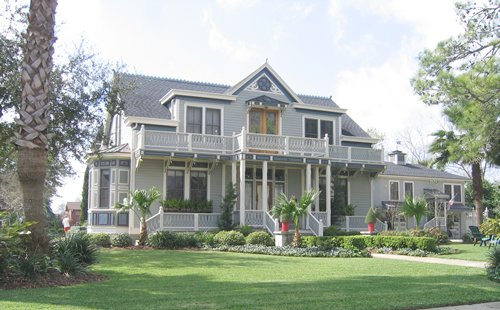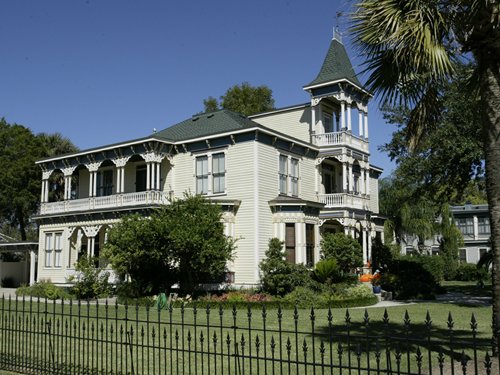|
Indianola,
once the “Queen City of the West,” recovered from a killer hurricane
in 1875 but it did not survive a second devastating storm in 1886.
Modern day visitors find few remnants of the once prosperous Calhoun
County seaport, but they’re looking in the wrong place. If you
want to see some of Indianola’s
stately Victorian houses, just go to Victoria
or Cuero.
|
The Beaumont-Steele
house at 501 N. De Leon in Victoria
Photo courtesy Gary Dunnam, Victoria Preservation, Inc. |
When
people read of the death toll associated with the Aug. 19, 1886 hurricane
(a wind-swept fire caused by an overturned kerosene lantern added
to the destruction), they tend to think the double calamity virtually
erased the city. Not so. Many well-built residences survived the storm
and fire.
But the people of Indianola
had had enough. They abandoned the town, relocating the county seat
to Port Lavaca.
On Oct. 4, 1887, even the post office closed.
Fine frame houses in the port city turned ghost town of Indianola
could be purchased for $50 to $250. Since no one wanted to live there
any longer, entrepreneurs had workmen take the houses apart piece
by piece and shipped them via railroad to points elsewhere.
Victoria
has at least five ghost town houses.
“Cuero
probably has even more,” says Gary Dunnam, director of Victoria Preservation,
Inc. “In the late 1880s and even into the 1890s, Cuero
was a bigger city than Victoria.”
According to
Dunnam, the Indianola remnants in Victoria
include:
The Beaumont-Steele
house at 501 N. De Leon
The Crain-Fox
house, a two-story white frame house with red and blue trim at 1601
N. Bridge St.
A two-story
house at 404 E. Goodwin was formerly owned by the A.M. McFaddin
estate.
The Dominick
H. Regan house, a detailed Italianate structure at 507 S. De Leon
The Huck-Welder
house at 307 E. Convent
|
 |
The Huck-Welder
house at 307 E. Convent, Victoria
Photo courtesy Gary Dunnam, Victoria Preservation, Inc. |
The
oldest of the Indianola survivors is the two-story Huck-Welder house
on Convent, in Victoria’s
once-elegant (and still nice) Diamond Hill neighborhood. H.J. Huck
built it in the late 1850s. A German immigrant, he imported the lumber
used to build much of ante bellum Texas, including the four-by-four-inch
Florida cypress timbers he used in the construction of his house.
After the 1886 hurricane, Huck’s son Francis had the house disassembled
and moved by rail to a lot in Victoria.
Jules Leffland, an architect who rose to prominence in Victoria,
supervised the rebuilding of the house.
A native of Denmark, then 30-year-old Leffland landed in Indianola
in time for that city’s May Day celebration in 1886. Less than four
months later, the hurricane struck. Leffland moved to Victoria,
where he soon oversaw the rebuilding of several former Indianola houses.
Huck and his family lived there until 1890, when he sold it to J.J.
Welder. The Welder family held the house until 1942.
When the house was restored in the late 1980s, a worker discovered
a board bearing Leffland’s signature and date. |
 |
The Dominick
H. Regan house, 507 S. De Leon, Victoria
Photo courtesy Gary Dunnam, Victoria Preservation, Inc. |
The Crain-Fox
house at 1601 N. Bridge St., Victoria
Photo courtesy Gary Dunnam, Victoria Preservation, Inc. |
404 E. Goodwin
in Victoria.
Formerly owned by the A.M. McFaddin estate.
Photo
courtesy Gary Dunnam, Victoria Preservation, Inc.
More Texas Historic Homes |
One
notable Indianola house in Cuero
is the Bates-Sheppard house at 312 Broadway, now home of the DeWitt
County Historical Museum.
As the 1886 Indianola hurricane raged, this house collapsed in the
wind and tidal surge. Mrs. Sheppard (her first name seems to be lost
in the various histories of the house) died when her house came apart
as did a friend’s two sons and two out-of-town visitors.
Henry Sheppard, Mrs. Sheppard’s 16-year-old son, floated away from
the house clutching a piece of lumber. Seeing someone else in the
water, he grabbed the person and later discovered it was his sister,
Jennie.
Later that fall, the surviving Sheppard family members returned to
Indianola
and had the remnants of their house shipped to Cuero,
where they rebuilt it. Homestead Nursery, 7 miles south of Cuero
on U.S. 183, is another structure that originally stood in Indianola.
It went to Cuero
first, where a man with the interesting name of Pius Fey operated
a photographic studio in it. Then the one-story building got moved
to its present location.
At
least one other remnant of old Indianola
is quite fitting – a partial tombstone from the city’s hurricane-ravaged
cemetery.
It’s a pie-shaped piece of white marble broken by the force of the
storm’s tidal surge. The portion with the name of the deceased is
lost, but the surviving part notes the person’s birth year as 1834
and a death date of July 1 or 7, 1867 at Indianola.
Now on display at the Nimitz
Museum in Fredericksburg,
the tombstone’s story is related in Doug and Fran Hubbard’s book,
“That Dog Will Hunt! Growing up with the Admiral Nimitz Museum.” According
to the book, someone from Fredericksburg
overheard Hubbard saying the museum needed something representative
of Indianola,
where so many Germans landed in Texas.
“Drop by our house and see what we are using for a door stop,” Bruce
Deatherage said to Hubbard.
Hubbard followed through and Deatherage ended up donating the piece
to the museum.
The book did not explain how the tombstone made it so far inland from
the coast.
© Mike Cox
"Texas Tales"
May 1, 2008 column |
| Books
by Mike Cox - Order Here |
|
|
